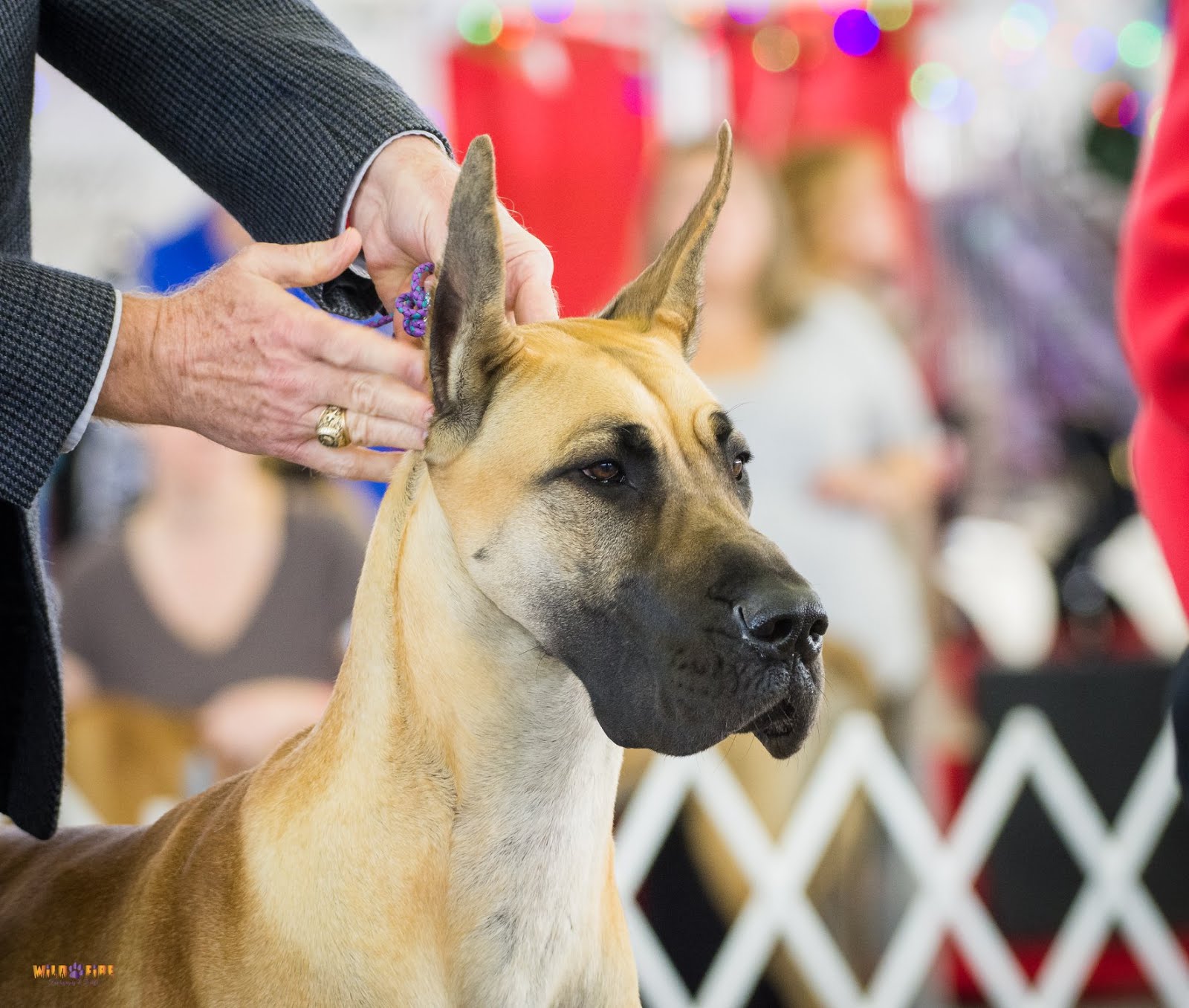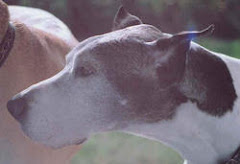Topper is doing absolutely great, and thank you for everyone who sent good wishes. The surgery was uneventful, as they say. If you are in the D/FW area, I can't recommend Drs Patty and Gregg Weber of All Care Veterinary Hospital enough. They have cared for my pets for almost 25 years now, and they are the best!!
But at 4 years old, Topper definitely had a more difficult time post-surgery than a younger dog would have. We are fortunate nowadays that we have a lot of excellent medications available to control pain in our animals, and between the Metacam and the Tramadol I don't think my girl was too uncomfortable those first few days.
But it did make me think...
In the past, I often got my female dogs spayed quite young - usually around 6 months of age. This is still a commonly recommended age for a spay and one of the reasons for that must be that pups DO heal a lot faster. A "spay" (i.e. ovariohysterectomy) is a major surgery after all. A 6 or 7 month old bitch often acts nearly normal the day after her spay. Whereas with Topper and her mother Kinsey (who was also 4 when she was spayed) it took a lot longer. They weren't incapacitated - they were able to walk within a few hours after the surgery, and were drinking water that night and eating by the next morning. But it was about 3 -4 days before they showed any real interest in playing or engaging in "normal" activity. Such as, in Topper's case, barking at the neighbors. *Sigh*
Obviously, if a bitch has the potential to be good enough to breed and her owner is willing to go through all the expense and hard work of raising a litter of puppies then there is no doubt that spaying her must be delayed - if it is done at all.
But for the bitch who won't or shouldn't be bred - should she be spayed at a young age? Some research indicates that spaying before she reaches maturity may not be the healthiest option and may even shorten her life. Here is the original article. This of course, is in contrast to evidence that spaying at an earlier age is best because it prevents certain cancers.
This position statement from the Society for Theriogenology (vets who are reproductive specialists) lays out both the pros and cons pretty well.
In my experience, there hasn't been a lot of difference. The two oldest Danes I've had to date (both died during their 11th year) were both spayed females. One was spayed at about 6 or 7 months, but I think she may have had a heat cycle - she was my first Dane and that was in 1976 so I don't remember the details. The other was spayed when she was about 18 months old.
Of course, there are some situations where I believe early spaying is always definitely indicated - such as when the puppy belongs to an owner who is unwilling or unable to responsibly care for an intact bitch. I believe that ALL female dogs adopted out of shelters or rescues should be spayed before going to their new homes - assuming they are healthy enough. If they aren't healthy enough and spaying must be delayed, those new homes should be screened extra carefully. Keeping an intact bitch from becoming accidentally impregnated isn't really that difficult, but it DOES require more knowledge than many pet owners possess.
But for knowledgeable pet owners there is no clear answer. Research into long-term negative effects of surgical sterilization is a relatively new field in veterinary medicine and it is possible that we are on the cusp of an upheaval no less dramatic than the uproar over vaccination protocols a few years ago. But there is also no doubt that there are negative aspects to delaying a major surgical procedure at least as regards recovery time and patient comfort.
If I had a puppy girl that I knew I wasn't ever going to be breeding, I'm not sure what I would do. One possible solution that I think is pretty exciting is having an ovariectomy done instead - this doesn't solve the problem of the removal of the hormones if they are needed for normal growth & development, but it is a less risky and possibly a less painful surgery. It might be a great choice for an older bitch - but I elected not to have this done with Topper because of her inherited risk of pyometra.
Ultimately, I hope that more responsible pet owners just do a little thinking, a little research before getting their pets spayed and neutered and make the most educated decision they can as to when to get these procedures done.
Saturday, December 19, 2009
Saturday, December 12, 2009
Lapful of Stripes!
I love this picture:
 It's Dakota's daddy Keeper sitting on a friend's lap. The camera perspective is hilarious - he's a big dog but not THAT big!! But this is a very typical Dane behavior - they are tall enough that they can just sit on a chair or couch while the front feet stay on the ground.
It's Dakota's daddy Keeper sitting on a friend's lap. The camera perspective is hilarious - he's a big dog but not THAT big!! But this is a very typical Dane behavior - they are tall enough that they can just sit on a chair or couch while the front feet stay on the ground.
Our dogs do this sort of thing all the time... so much so that I have thought about changing our answering machine message to "Barb and Ronnie are home, but have giant dogs in their laps right now and can't get up to get the phone. We will call you back when the dogs decide to move."
 It's Dakota's daddy Keeper sitting on a friend's lap. The camera perspective is hilarious - he's a big dog but not THAT big!! But this is a very typical Dane behavior - they are tall enough that they can just sit on a chair or couch while the front feet stay on the ground.
It's Dakota's daddy Keeper sitting on a friend's lap. The camera perspective is hilarious - he's a big dog but not THAT big!! But this is a very typical Dane behavior - they are tall enough that they can just sit on a chair or couch while the front feet stay on the ground.Our dogs do this sort of thing all the time... so much so that I have thought about changing our answering machine message to "Barb and Ronnie are home, but have giant dogs in their laps right now and can't get up to get the phone. We will call you back when the dogs decide to move."
Monday, December 07, 2009
Snip, Snip
Well, Topper is going under the knife tomorrow morning. I am a little sad about it...she is a WONDERFUL dog - smart and friendly. She's beautiful too, although that is somewhat less important than other factors.
When we bred her mother Kinsey, my main hope was that we would get a nice brindle girl. And we did! Topper is a lovely girl. But we have decided not to breed her.
I know that no dog is perfect... but it has become evident that there are too many reproductive problems with the females in this family. Kinsey had to have a C-section to have her puppies - although thanks to careful monitoring we were alerted to that fact long before either Kinsey or her puppies were in any distress, so everyone survived just fine. Later Kinsey had an open pyometra which was successfully treated, but then after she recovered from that we had her spayed.
Since then, Topper's grandmother, aunt and a couple of other female relatives have had pyometra, and some of them died. Although any intact female can develop a uterine infection, it is actually not that common and most intact bitches live their whole lives without any problems. But it seems to be more common than the norm with this family. A LOT more common. And pyometra can be a killer.
So although Topper herself has never had pyo, she is getting spayed in the morning. I am a little sad that we won't be breeding her... but I will be relieved that I won't have to worry about her developing a dangerous infection.
This is what responsible breeders do - we try to only breed the very best dogs that we can. Getting titles and championships, and getting health clearances is only part (although a very important part) of the puzzle. You also have to do some detective work to see what problems there are in the pedigree - and there will always be something. It might be something "fixable" by carefully selecting future mates. Or it might be something so catastrophic that the only solution is to scrap your entire breeding program. This is somewhere in between - important enough to decide to never breed Topper.
But the males in the bloodline produce daughters that do NOT have these problems, which is why we got Dakota. She is the daughter of Topper's brother Keeper. I don't want to make it sound like we got Dakota just to breed her... we got her because it was time for us to start the next generation and we needed to have a puppy in training. Besides, it is too early to tell if she will be worthy of being bred. It all depends on how she grows up, if she passes all the health tests, etc. etc. etc.
But we are hopeful!
And in the meantime, send good thoughts for Topper. She's gonna need a LOT of TLC in the next few days! Poor baby...
When we bred her mother Kinsey, my main hope was that we would get a nice brindle girl. And we did! Topper is a lovely girl. But we have decided not to breed her.
I know that no dog is perfect... but it has become evident that there are too many reproductive problems with the females in this family. Kinsey had to have a C-section to have her puppies - although thanks to careful monitoring we were alerted to that fact long before either Kinsey or her puppies were in any distress, so everyone survived just fine. Later Kinsey had an open pyometra which was successfully treated, but then after she recovered from that we had her spayed.
Since then, Topper's grandmother, aunt and a couple of other female relatives have had pyometra, and some of them died. Although any intact female can develop a uterine infection, it is actually not that common and most intact bitches live their whole lives without any problems. But it seems to be more common than the norm with this family. A LOT more common. And pyometra can be a killer.
So although Topper herself has never had pyo, she is getting spayed in the morning. I am a little sad that we won't be breeding her... but I will be relieved that I won't have to worry about her developing a dangerous infection.
This is what responsible breeders do - we try to only breed the very best dogs that we can. Getting titles and championships, and getting health clearances is only part (although a very important part) of the puzzle. You also have to do some detective work to see what problems there are in the pedigree - and there will always be something. It might be something "fixable" by carefully selecting future mates. Or it might be something so catastrophic that the only solution is to scrap your entire breeding program. This is somewhere in between - important enough to decide to never breed Topper.
But the males in the bloodline produce daughters that do NOT have these problems, which is why we got Dakota. She is the daughter of Topper's brother Keeper. I don't want to make it sound like we got Dakota just to breed her... we got her because it was time for us to start the next generation and we needed to have a puppy in training. Besides, it is too early to tell if she will be worthy of being bred. It all depends on how she grows up, if she passes all the health tests, etc. etc. etc.
But we are hopeful!
And in the meantime, send good thoughts for Topper. She's gonna need a LOT of TLC in the next few days! Poor baby...
Saturday, December 05, 2009
Ebony and Ivory
Well, maybe not... but these two Danes of a different color sure get along swell.
 The Harlequin is Riddle, an 8 month old pup who belongs to a friend of ours. Riddle stayed here this evening because she's going with us to a show in the morning.
The Harlequin is Riddle, an 8 month old pup who belongs to a friend of ours. Riddle stayed here this evening because she's going with us to a show in the morning.
Her owner will pick her up tomorrow, and I know one brindle puppy who is going to be very sad to see her go! They have had a wonderful day.
And so it began...





And into the night...
 They actually are still playing now at 10:30 pm. I am going to have to put them to bed in their crates if any of us is going to get some sleep!!
They actually are still playing now at 10:30 pm. I am going to have to put them to bed in their crates if any of us is going to get some sleep!!
 The Harlequin is Riddle, an 8 month old pup who belongs to a friend of ours. Riddle stayed here this evening because she's going with us to a show in the morning.
The Harlequin is Riddle, an 8 month old pup who belongs to a friend of ours. Riddle stayed here this evening because she's going with us to a show in the morning. Her owner will pick her up tomorrow, and I know one brindle puppy who is going to be very sad to see her go! They have had a wonderful day.
And so it began...





And into the night...
 They actually are still playing now at 10:30 pm. I am going to have to put them to bed in their crates if any of us is going to get some sleep!!
They actually are still playing now at 10:30 pm. I am going to have to put them to bed in their crates if any of us is going to get some sleep!!
Wednesday, December 02, 2009
Hooey
I started leaving this response in the comments section, but then decided to make a new post so maybe more people would see it.
Anonymous wrote:
Well Anonymous (from Huntington Beach, CA >:-)) I wish you had the guts to sign your post. I could remove your comment - and maybe I should since it just reflects the kind of unthinking knee-jerk rhetoric found with people who... well, with people who don't have the guts to sign their posts!
But I'm going to respond because this sort of rhetoric is catchy, and I do know people who are normally smart and thoughtful who get caught up in it anyway just because they don't take the time to do a little research or critical thinking.
First, as to the "butchery" - give me a huge break. We use a great vet to do our ear crops, very safe anesthetic protocols, and excellent pain management afterward. The pups recover almost instantly - and since puppies are not exactly known for being stoic, I can only assume that a puppy who is bouncing and playing and acting like a little devil within hours of waking up from the surgery is NOT suffering! Once the ears are healed, the process of taping to brace them erect is not uncomfortable (or should not be, I'm working on a post about ear taping) and is just another grooming activity that the pup learns is actually an OK thing. Like being brushed, having feet and mouth handled, etc, etc.
Maybe not everyone takes as much care to be sure their puppy doesn't suffer during the process but that doesn't mean the procedure itself is cruel. That would be like saying that just because some people use cruel training methods that no one should train a dog, or just because some owners are negligent or abusive then no one should own a pet.
But mostly I want to address your reference to the "don't breed or buy while shelter pets die" type hooey.
First, if you had read some of my other posts or looked at my web site, you would know that A) yes these pups DO come from a very ethical breeder who brought them into the world with great care and planning and who will be responsible for them forever.
And B) you would know that I have volunteered for Rescue for 25+ years, have fostered more than 70 Danes in my home during that time and donated thousands of hours on the phone, hundreds of transportation miles, and God only knows how many dollars toward the effort of finding homes for needy dogs. I don't do this because I feel "guilty" about having bred a litter or about buying puppies from responsible breeders - I do it for the same reasons that responsible breeders have been doing rescue all along (did you know that the modern concept of "rescue" was INVENTED by responsible breeders??) - I do it because I love this breed so much that I don't want to see any of them suffer, even those that I am in no way responsible for.
There are two reasons I say the "don't buy" mantra is hooey - one is partly because I DO believe there ARE enough homes for all the adoptable dogs in shelters, IF we just try a little bit harder to reach more people. Too many communities (including poor/rural ones) have reached very low kill status to deny this. I'm not going to provide links - Google "no kill" and you'll get all the proof you need IF you are willing to open up your mind. I ALWAYS suggest adopting from rescue when I talk to someone who is thinking about adding a new dog to their household - but that is just not the best option for everyone. There really are good reasons for wanting to buy a puppy from a responsible breeder.
The second reason is, whether or not there are enough homes for all the homeless dogs - who do you want to be producing the next generation of our pets? Fact is, the irresponsible breeders will always be with us as long as there are people buying their puppies. No amount of legislation or slogans or even peer pressure will stop that.
But the responsible breeders ARE sensitive to both peer/popular pressure and to legislation. If people like you convince them to stop breeding then the only pets available will have come from the other kind of breeder. I, for one, love this breed MUCH too much to leave its future in the hands of people who breed only for profit or out of carelessness. Our ONLY hope of improving the overall health and longevity of this beautiful breed - while keeping their sweet nature - is to let the responsible breeders work at it.
Anonymous wrote:
I just don't understand the human concept or mindset of butchering dogs ears, not necessary folks. And I will hope that these pups are from highly responsible breeders. As one that has rescued/fosterd many Great Danes, there are too many waiting for homes, they may not be the puppy stage, but they have paid their dues and deserve a real life. Go Rescue and Shelter folks and save a life.
Well Anonymous (from Huntington Beach, CA >:-)) I wish you had the guts to sign your post. I could remove your comment - and maybe I should since it just reflects the kind of unthinking knee-jerk rhetoric found with people who... well, with people who don't have the guts to sign their posts!
But I'm going to respond because this sort of rhetoric is catchy, and I do know people who are normally smart and thoughtful who get caught up in it anyway just because they don't take the time to do a little research or critical thinking.
First, as to the "butchery" - give me a huge break. We use a great vet to do our ear crops, very safe anesthetic protocols, and excellent pain management afterward. The pups recover almost instantly - and since puppies are not exactly known for being stoic, I can only assume that a puppy who is bouncing and playing and acting like a little devil within hours of waking up from the surgery is NOT suffering! Once the ears are healed, the process of taping to brace them erect is not uncomfortable (or should not be, I'm working on a post about ear taping) and is just another grooming activity that the pup learns is actually an OK thing. Like being brushed, having feet and mouth handled, etc, etc.
Maybe not everyone takes as much care to be sure their puppy doesn't suffer during the process but that doesn't mean the procedure itself is cruel. That would be like saying that just because some people use cruel training methods that no one should train a dog, or just because some owners are negligent or abusive then no one should own a pet.
But mostly I want to address your reference to the "don't breed or buy while shelter pets die" type hooey.
First, if you had read some of my other posts or looked at my web site, you would know that A) yes these pups DO come from a very ethical breeder who brought them into the world with great care and planning and who will be responsible for them forever.
And B) you would know that I have volunteered for Rescue for 25+ years, have fostered more than 70 Danes in my home during that time and donated thousands of hours on the phone, hundreds of transportation miles, and God only knows how many dollars toward the effort of finding homes for needy dogs. I don't do this because I feel "guilty" about having bred a litter or about buying puppies from responsible breeders - I do it for the same reasons that responsible breeders have been doing rescue all along (did you know that the modern concept of "rescue" was INVENTED by responsible breeders??) - I do it because I love this breed so much that I don't want to see any of them suffer, even those that I am in no way responsible for.
There are two reasons I say the "don't buy" mantra is hooey - one is partly because I DO believe there ARE enough homes for all the adoptable dogs in shelters, IF we just try a little bit harder to reach more people. Too many communities (including poor/rural ones) have reached very low kill status to deny this. I'm not going to provide links - Google "no kill" and you'll get all the proof you need IF you are willing to open up your mind. I ALWAYS suggest adopting from rescue when I talk to someone who is thinking about adding a new dog to their household - but that is just not the best option for everyone. There really are good reasons for wanting to buy a puppy from a responsible breeder.
The second reason is, whether or not there are enough homes for all the homeless dogs - who do you want to be producing the next generation of our pets? Fact is, the irresponsible breeders will always be with us as long as there are people buying their puppies. No amount of legislation or slogans or even peer pressure will stop that.
But the responsible breeders ARE sensitive to both peer/popular pressure and to legislation. If people like you convince them to stop breeding then the only pets available will have come from the other kind of breeder. I, for one, love this breed MUCH too much to leave its future in the hands of people who breed only for profit or out of carelessness. Our ONLY hope of improving the overall health and longevity of this beautiful breed - while keeping their sweet nature - is to let the responsible breeders work at it.
Subscribe to:
Posts (Atom)










